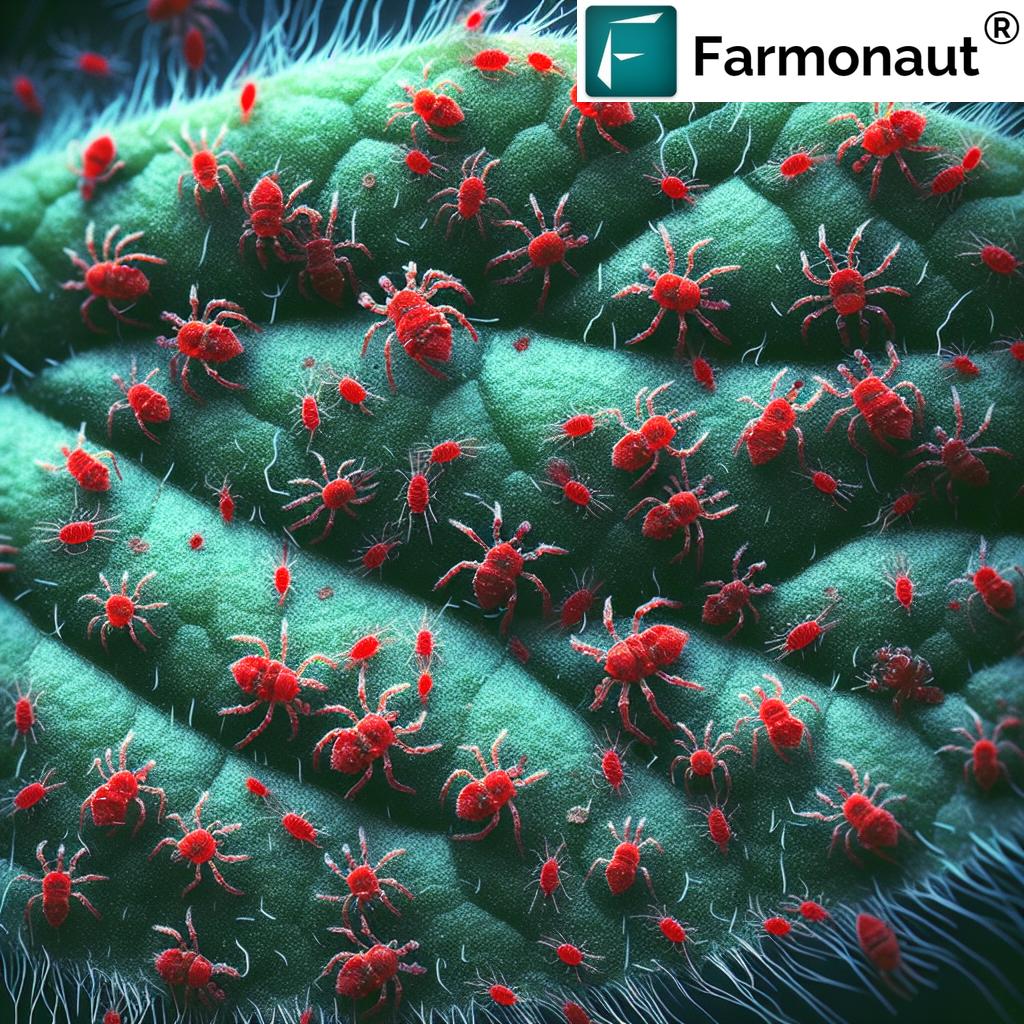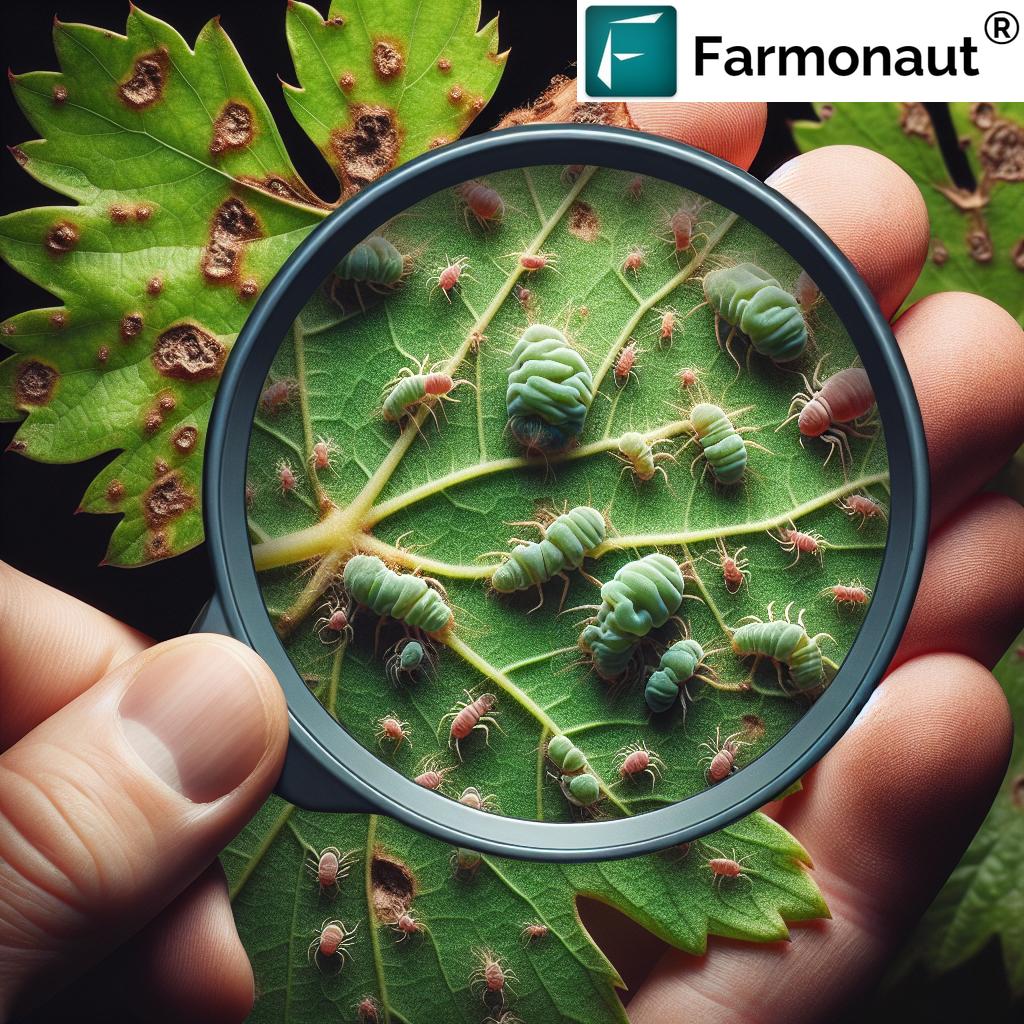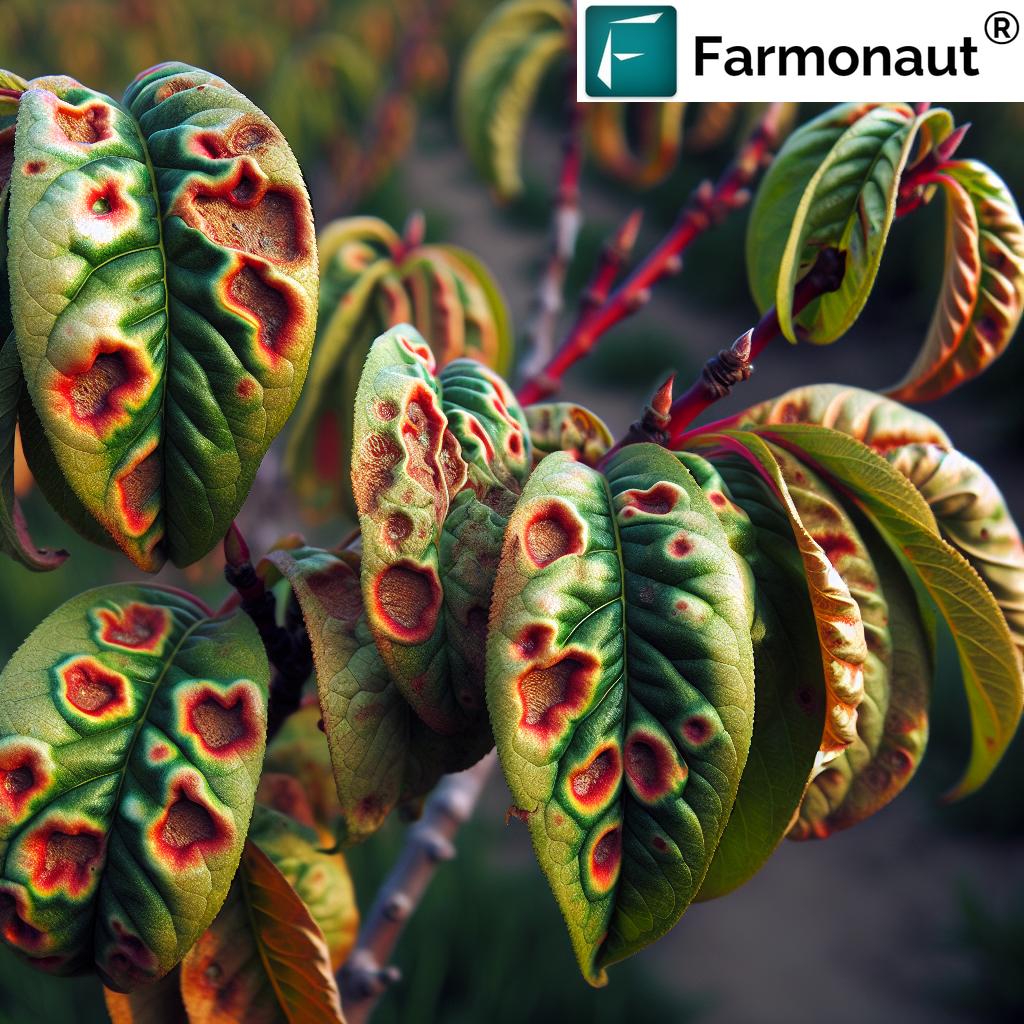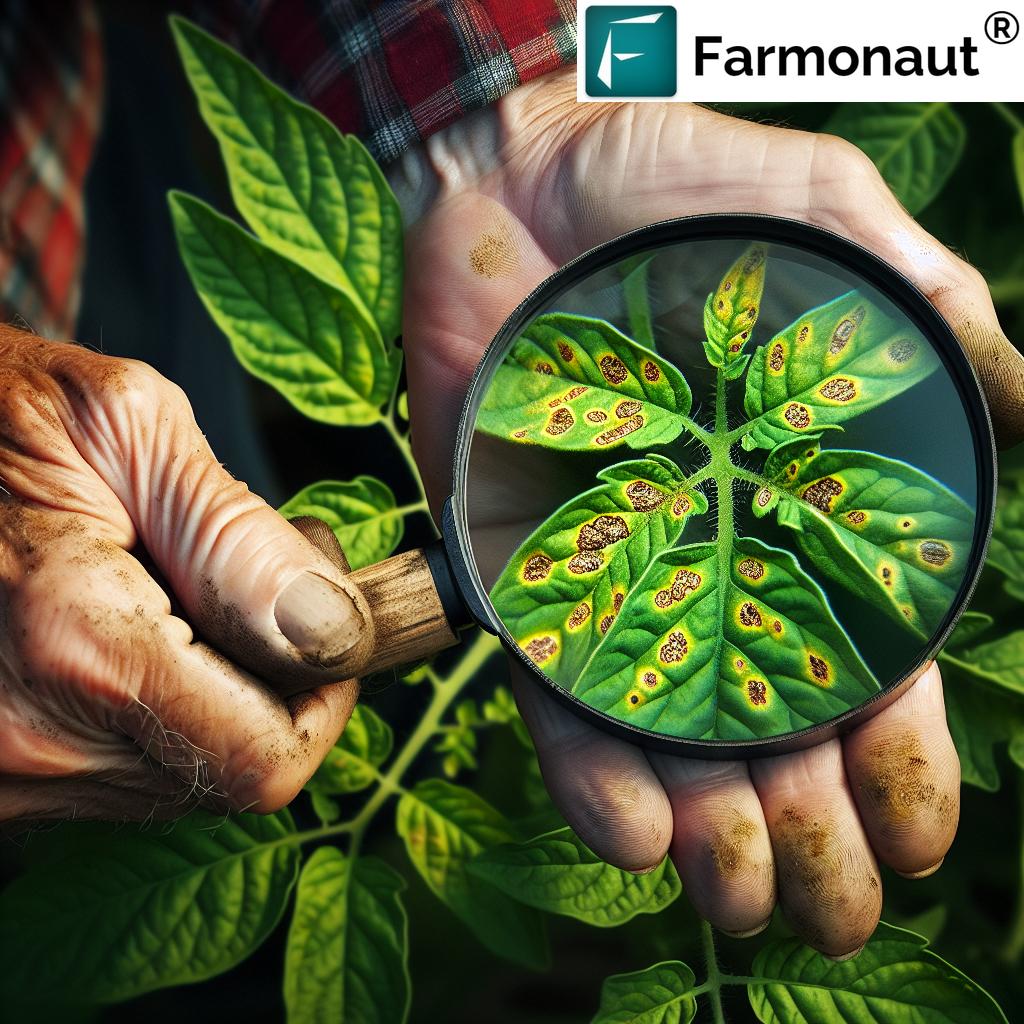Organic Management of Red Spider Mites: Protecting Plants from Tetranychus and Panonychus Species

In the world of agriculture and horticulture, pests pose a significant threat to plant health and crop yields. Among these pests, red spider mites stand out as particularly troublesome insects that can wreak havoc on a wide variety of plants. At Farmonaut, we understand the challenges farmers face in managing these tiny yet destructive pests, and we’re committed to providing innovative solutions for effective and organic pest control.
Understanding Red Spider Mites: The Tiny Terrors of the Plant World
Red spider mites, also known as two-spotted spider mites, belong to the family Tetranychidae. These arachnids are not true insects but are closely related to spiders. The two most common genera affecting crops are Tetranychus and Panonychus. These mites are incredibly small, measuring only about 0.4 mm in length, making them difficult to spot with the naked eye.
Identifying Red Spider Mites
To effectively manage red spider mites, it’s crucial to be able to identify them and recognize the signs of an infestation. Here are some key characteristics to look out for:
- Color: Despite their name, red spider mites can vary in color. They may appear red, green, brown, or yellow, depending on their life stage and diet.
- Shape: These mites have oval-shaped bodies with eight legs.
- Webbing: One of the most distinctive signs of a spider mite infestation is the fine silk webbing they produce on the undersides of leaves.
- Damage: Look for tiny yellow or white speckles on leaves, which are caused by the mites feeding on plant cells.
Life Cycle and Reproduction
Understanding the life cycle of red spider mites is essential for effective management. These pests can reproduce rapidly under favorable conditions, leading to explosive population growth. The life cycle consists of the following stages:
- Egg: Females lay small, spherical eggs on the undersides of leaves.
- Larva: After hatching, the six-legged larva begins feeding on the plant.
- Protonymph: The larva molts into an eight-legged protonymph.
- Deutonymph: Another molting occurs, resulting in the deutonymph stage.
- Adult: The final molt produces a sexually mature adult mite.
Under optimal conditions (warm and dry), the entire life cycle can be completed in as little as 5-7 days. This rapid reproduction rate is one of the reasons why red spider mite infestations can quickly spiral out of control if not addressed promptly.
The Impact of Red Spider Mites on Plants
Red spider mites can cause significant damage to a wide range of plants, including crops, ornamentals, and even indoor houseplants. Their feeding behavior involves piercing plant cells and sucking out the contents, which leads to various symptoms:
- Stippling: Small, light-colored spots appear on leaves where the mites have fed.
- Bronzing: As feeding continues, leaves may take on a bronze or reddish appearance.
- Leaf drop: Severe infestations can cause leaves to dry out and fall off prematurely.
- Reduced photosynthesis: Damaged leaves are less efficient at photosynthesis, affecting overall plant health.
- Yield loss: In agricultural crops, mite damage can lead to reduced yields and lower quality produce.
The economic impact of red spider mite infestations can be substantial, particularly in high-value crops such as fruits, vegetables, and ornamental plants. Early detection and intervention are crucial for minimizing damage and preventing yield losses.
Factors Influencing Red Spider Mite Infestations
Several environmental and cultural factors can influence the severity and spread of red spider mite infestations. Understanding these factors can help in developing effective prevention and management strategies:
Weather Conditions
Weather plays a significant role in the population dynamics of red spider mites. These pests thrive in hot, dry conditions, which accelerate their reproduction rate and can lead to rapid population explosions. Key weather-related factors include:
- Temperature: Optimal temperatures for mite development range from 25°C to 30°C (77°F to 86°F).
- Humidity: Low relative humidity (below 50%) favors mite populations.
- Rainfall: Frequent rain can help suppress mite populations by washing them off plants and increasing humidity.
At Farmonaut, we understand the critical role that weather plays in pest management. Our satellite-based monitoring system provides real-time weather data and forecasts, allowing farmers to anticipate potential mite outbreaks and take proactive measures. To learn more about our weather monitoring capabilities, visit Farmonaut’s Weather API Documentation.
Plant Stress
Stressed plants are more susceptible to mite infestations. Factors that can increase plant stress include:
- Drought conditions
- Nutrient deficiencies
- Improper pruning
- Root damage
- Overcrowding
Maintaining optimal growing conditions and proper plant care can help reduce the risk of mite infestations.
Pesticide Use
Ironically, the overuse of broad-spectrum insecticides can actually exacerbate spider mite problems. This occurs for two main reasons:
- Elimination of natural predators: Broad-spectrum insecticides kill beneficial insects that naturally control mite populations.
- Resistance development: Frequent use of the same chemical controls can lead to the development of resistant mite populations.
This is one of the reasons why we at Farmonaut advocate for integrated pest management (IPM) approaches that prioritize organic and biological control methods.
Organic Management Strategies for Red Spider Mites
At Farmonaut, we believe in sustainable and environmentally friendly approaches to pest control. Here are some effective organic strategies for managing red spider mite infestations:
Cultural Control Methods
Implementing good cultural practices can help prevent mite infestations and reduce their severity:
- Proper irrigation: Maintain adequate soil moisture to reduce plant stress and create less favorable conditions for mites.
- Dust reduction: Regularly wash plants with a strong spray of water to remove dust, which can harbor mites.
- Pruning and spacing: Proper pruning and plant spacing improve air circulation, making the environment less conducive to mite populations.
- Crop rotation: Rotating crops can help break the mite life cycle and reduce carryover populations.
- Weed management: Control weeds that can serve as alternative hosts for mites.
Biological Control
Encouraging and introducing natural predators of spider mites is an effective and environmentally friendly control method. Some beneficial insects that prey on spider mites include:
- Predatory mites (e.g., Phytoseiulus persimilis, Neoseiulus californicus)
- Ladybugs
- Lacewings
- Minute pirate bugs
- Predatory thrips
These beneficial insects can be introduced into the field or greenhouse to help control mite populations naturally. Creating habitat for these predators, such as planting flowering plants nearby, can also help attract and sustain their populations.
Botanical and Organic Pesticides
When cultural and biological controls are insufficient, organic pesticides can be used as part of an integrated management approach. Some effective options include:
- Neem oil: This natural pesticide derived from the neem tree is effective against many pests, including spider mites. It works by disrupting the mites’ hormonal systems and acting as a repellent.
- Insecticidal soaps: These specially formulated soaps can kill mites on contact while being relatively safe for beneficial insects.
- Horticultural oils: Oils such as mineral oil or vegetable-based oils can suffocate mites and their eggs.
- Sulfur: When applied as a dust or spray, sulfur can be an effective miticide, especially in drier climates.
- Pyrethrin: Derived from chrysanthemum flowers, pyrethrin is a natural insecticide that can control mites when used properly.
It’s important to note that even organic pesticides should be used judiciously and in accordance with label instructions to minimize harm to beneficial insects and the environment.
Advanced Detection and Monitoring with Farmonaut
Early detection is crucial for effective mite management. At Farmonaut, we’ve developed cutting-edge technology to help farmers identify and monitor pest infestations, including red spider mites, with unprecedented accuracy and efficiency.

Satellite-Based Crop Monitoring
Our satellite-based crop monitoring system provides real-time insights into plant health across large areas. By analyzing multispectral imagery, we can detect subtle changes in vegetation that may indicate the early stages of a mite infestation. This allows farmers to take action before the problem becomes severe.
Comparison: Traditional vs. Farmonaut Satellite System Detection
| Feature | Traditional Mite Detection | Farmonaut Satellite System Detection |
|---|---|---|
| Detection Speed | Slow (manual scouting required) | Fast (real-time satellite imagery analysis) |
| Accuracy | Variable (depends on scout’s expertise) | High (AI-powered image analysis) |
| Coverage Area | Limited (time-consuming to cover large areas) | Extensive (can monitor entire fields simultaneously) |
| Early Intervention Potential | Low (often detects infestations after visible damage) | High (detects stress before visible symptoms appear) |
By leveraging our advanced satellite technology, farmers can implement organic management strategies more effectively and with greater precision. To learn more about our crop monitoring capabilities, visit Farmonaut’s App or explore our API documentation.
Integrated Pest Management (IPM) for Red Spider Mites
At Farmonaut, we advocate for an Integrated Pest Management (IPM) approach to controlling red spider mites. IPM combines various control methods to manage pest populations effectively while minimizing environmental impact and reducing the risk of pesticide resistance. Here’s how to implement an IPM strategy for red spider mites:
1. Prevention
- Maintain plant health through proper nutrition and irrigation
- Implement sanitation practices to reduce mite habitats
- Use resistant plant varieties when available
- Create barriers to prevent mite migration between plants
2. Monitoring
- Regularly inspect plants for signs of mite activity
- Use Farmonaut’s satellite monitoring system for early detection
- Employ sticky traps or leaf samples to track mite populations
- Keep detailed records of mite activity and control measures
3. Threshold-Based Decision Making
- Establish economic thresholds for mite populations
- Initiate control measures only when thresholds are exceeded
- Consider crop stage, weather conditions, and natural enemy populations when making decisions
4. Control Methods
- Start with the least disruptive methods (e.g., water sprays, pruning)
- Introduce biological control agents
- Apply botanical and organic pesticides when necessary
- Use synthetic pesticides as a last resort, focusing on selective products
5. Evaluation and Adjustment
- Assess the effectiveness of control measures
- Adjust strategies based on results and changing conditions
- Continuously update your IPM plan to improve efficacy
By following these IPM principles and utilizing Farmonaut’s advanced monitoring tools, farmers can effectively manage red spider mite populations while minimizing environmental impact and preserving beneficial insect populations.
Case Studies: Successful Organic Management of Red Spider Mites
While we at Farmonaut do not provide specific case studies, we have observed numerous successful implementations of organic management strategies for red spider mites across various crops and regions. Here are some general examples of effective organic control methods:
Greenhouse Tomato Production
In controlled greenhouse environments, many tomato growers have successfully managed red spider mites using a combination of:
- Regular releases of predatory mites (Phytoseiulus persimilis)
- Maintaining optimal humidity levels (around 60-70%)
- Weekly applications of neem oil or insecticidal soap
- Pruning and removing heavily infested leaves
Organic Apple Orchards
Apple growers implementing organic practices have controlled spider mites through:
- Encouraging populations of predatory mites and insects
- Using kaolin clay as a deterrent
- Applying horticultural oils during dormant seasons
- Maintaining proper irrigation to reduce tree stress
Outdoor Vegetable Crops
Vegetable farmers have reported success in managing spider mites organically by:
- Implementing crop rotation strategies
- Using overhead irrigation to increase humidity and wash off mites
- Planting trap crops or companion plants that attract beneficial insects
- Applying sulfur dusts in dry conditions
These examples demonstrate that with a comprehensive approach and consistent monitoring, organic management of red spider mites is not only possible but can be highly effective across various agricultural settings.
The Role of Technology in Organic Mite Management
At Farmonaut, we believe that technology plays a crucial role in enhancing organic pest management strategies. Our advanced tools and services help farmers implement more effective and efficient mite control measures:
Precision Monitoring
Our satellite-based monitoring system provides high-resolution imagery and vegetation health indices that can detect early signs of mite infestations. This allows farmers to:
- Identify problem areas before visible symptoms appear
- Target control measures more precisely, reducing overall pesticide use
- Monitor the effectiveness of organic control strategies in real-time
Weather Forecasting and Alerts
Accurate weather forecasting is crucial for predicting mite outbreaks and optimizing control measures. Our system provides:
- Detailed local weather forecasts
- Alerts for conditions favorable to mite population growth
- Recommendations for timing of organic pesticide applications
Data-Driven Decision Making
By collecting and analyzing data on mite populations, weather conditions, and treatment efficacy, farmers can make more informed decisions about their pest management strategies. Our platform offers:
- Historical data analysis to identify trends and patterns
- Integration of multiple data sources for comprehensive insights
- AI-powered recommendations for optimizing organic control measures
To explore how Farmonaut’s technology can enhance your organic mite management practices, visit our Android app or iOS app.
Future Trends in Organic Mite Management
As we look to the future, several emerging trends and technologies promise to further improve organic management of red spider mites:
1. Biocontrol Advancements
Research into new species of predatory mites and other natural enemies is ongoing. We anticipate the development of more effective and resilient biocontrol agents that can thrive in various environmental conditions.
2. Precision Application Technologies
Drone and robotic technologies are evolving to allow for ultra-precise application of organic pesticides and beneficial insects, reducing waste and improving efficacy.
3. Plant Breeding for Resistance
Advanced breeding techniques, including CRISPR gene editing, may lead to the development of plant varieties with enhanced natural resistance to spider mites.
4. Artificial Intelligence in Pest Management
AI algorithms will continue to improve, offering even more accurate predictions of mite outbreaks and personalized management recommendations based on vast datasets.
5. Nanotechnology in Organic Pesticides
Nanoformulations of organic pesticides may enhance their efficacy and persistence while maintaining their eco-friendly properties.
6. Climate-Adaptive Strategies
As climate change affects pest populations and distributions, we expect to see the development of more adaptive and resilient organic management strategies.
At Farmonaut, we’re committed to staying at the forefront of these technological advancements, continuously improving our platform to provide farmers with the most effective tools for organic pest management.
Conclusion
Organic management of red spider mites presents both challenges and opportunities for modern agriculture. By combining time-tested organic practices with cutting-edge technology, farmers can effectively control these persistent pests while maintaining environmental sustainability and produce quality.
At Farmonaut, we’re dedicated to empowering farmers with the tools and knowledge they need to implement successful organic pest management strategies. Our satellite-based monitoring system, weather forecasting capabilities, and data-driven insights provide a comprehensive solution for detecting, monitoring, and managing red spider mite infestations.
As we move forward, the integration of advanced technologies with organic farming principles will continue to drive innovation in pest management. By staying informed about the latest developments and leveraging tools like those offered by Farmonaut, farmers can stay ahead of the curve in their battle against red spider mites and other agricultural pests.
We invite you to explore our platform and see how Farmonaut can transform your approach to organic pest management. Together, we can cultivate a more sustainable and productive future for agriculture.
FAQs about Organic Management of Red Spider Mites
- Q: How can I tell if my plants have red spider mites?
A: Look for tiny specks on leaves, fine webbing on the undersides of leaves, and a stippled or bronzed appearance of foliage. You may also see the mites themselves, which appear as small moving dots. - Q: Are neem oil treatments effective against red spider mites?
A: Yes, neem oil can be an effective organic treatment for spider mites. It works by disrupting the mites’ hormonal systems and acting as a repellent. Regular applications may be necessary for optimal control. - Q: How often should I monitor my plants for spider mites?
A: Regular monitoring is crucial. We recommend checking plants at least once a week, and more frequently during hot, dry weather when mite populations can explode rapidly. - Q: Can I use predatory mites for spider mite control in my home garden?
A: Absolutely! Predatory mites can be an excellent biological control option for home gardens. They’re available from many garden supply stores and can be an effective, chemical-free way to manage spider mite populations. - Q: How does Farmonaut’s technology help in managing spider mites organically?
A: Our satellite-based monitoring system can detect early signs of mite infestations by analyzing vegetation health. This allows for timely intervention with organic control methods before the infestation becomes severe. - Q: Are there any plants that naturally repel spider mites?
A: While no plant completely repels spider mites, some companion plants like garlic, onions, and chrysanthemums may help deter them. These plants can be incorporated into your garden as part of an integrated pest management strategy. - Q: How do weather conditions affect spider mite populations?
A: Spider mites thrive in hot, dry conditions. High temperatures accelerate their reproduction rate, while low humidity reduces mortality from fungal diseases that naturally control mite populations. - Q: Can overhead watering help control spider mites?
A: Yes, overhead watering or spraying plants with a strong jet of water can help knock mites off plants and increase humidity, creating less favorable conditions for mite populations. However, be cautious with plants that are susceptible to fungal diseases in high-moisture environments. - Q: How can I prevent spider mite infestations in my greenhouse?
A: Maintain proper humidity levels, regularly inspect and quarantine new plants, use yellow sticky traps to monitor populations, and consider preventive releases of predatory mites. Our Farmonaut app can also help by providing early warning of conditions favorable for mite outbreaks. - Q: Are organic treatments for spider mites as effective as chemical pesticides?
A: When implemented properly as part of an integrated pest management strategy, organic treatments can be highly effective. While they may work more slowly than some chemical options, they’re often more sustainable in the long term and less likely to lead to pesticide resistance.
For more information on how Farmonaut can help you implement effective organic pest management strategies, including control of red spider mites, please visit our website or contact our support team.













